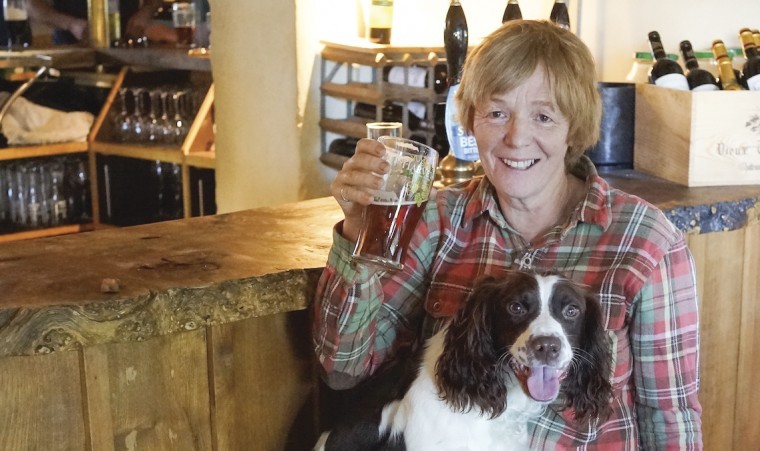March lived up to its reputation and came in like a lion. The Beast from the East blew in an inescapable bitter chill wind while I was lookering on the Pevensey levels.
But there is more grass here than at home, our sheep are resilient and by necessity so are farmers. It wasn’t much fun thawing out frozen water pipes in the cattle sheds either. Our cattle were melodramatic, acting like they’d been stranded in the desert for days when actually the troughs had merely stopped working overnight. They drank excessively. We were fortunate that we didn’t get too much snow. The white stuff may look pretty in pictures but causes disruption and inconvenience.
Snowy conditions bought much of our country to a standstill but that simply isn’t an option for livestock farmers needing to get food and water to their animals. While working in freezing temperatures, wearing many layers seems sensible, but is it? As soon as you start to work the extra clothes become cumbersome and heaven forbid should you get a call of nature. It felt like we worked hard all day achieving very little. Perhaps you get used to the cold, or do we English just like to make a big fuss?
The news reporters went into a frenzy. But farmers did get some positive media coverage which was heartening: it makes a pleasant change to be hailed as heroes rather than villains. I was astounded to hear one breakfast news presenter comment “Farmers ride around on their tractors all day, they might as well make themselves useful.” Sadly this demonstrates the general public’s lack of understanding about farming and this needs addressing.
Incidentally I was irate this week after receiving communication addressed to us. Inside was a flier entitled: “The merchant for farmers.” Underneath this was a figure grasping a pitch fork in one hand, while his other hand was on his hip. He was bearded, with sticking out ears, chubby cheeks and huge nose. A large brown unflattering hat was perched on his head. He was wearing blue dungarees and sporting a rather large belly. This outdated stereotype image doesn’t come anywhere close to depicting me, my husband or any other farmer that I can think of! It does us no favours. An updated rebrand is well overdue: rant over.
Looking on the bright side of adverse weather conditions, children had lots of fun tobogganing in the snow and creating magical snowmen. Often the community spirit is improved. People are more inclined to look out for the elderly and vulnerable. Temporary shelters and food were supplied for the rough sleepers. When the thaw came, burst pipes disrupted water supply for many. Several farmers were grateful to Mayfield fire brigade for providing an efficient service of pumping water from the river into mobile tanks enabling farmers to get water to their stock. Handouts of bottled water simply isn’t enough.
Shockingly researchers have discovered that more than 90% of bottled water brands contain at least twice the number of plastic fibres in them than found in tap water. I’ve never understood why people happily pay for water in a bottle when it is readily available from a tap. The impact on our health of these nanoplastic particles is not yet known. However a study has shown that exposing fish to the chemicals used in the production of plastics causes the fish to exhibit anxiety like behaviours later in life. It is now being asked whether there is a link between plastics and dementia.
As a shopper I feel that food is often presented to the consumer using excessive and unnecessary packaging. We need some sustainably sourced environmentally friendly alternative products to replace the use of plastics in the retail food industry. For example I understand that carrier bags made from materials such as potato starch are being tested, which sounds hopeful. Also, as a plea from a housewife unwrapping packaging, it would be helpful if it was clearly labelled as to whether it is recyclable.
Newspapers have recently drawn attention to misleading descriptions and images displayed on food labels. The introduction of an honest labelling system, with a more accurate description as to how food is produced could benefit smaller producers. Easy to understand labelling would enable the consumer to make more informed choices when buying food from a supermarket.
Those buying meat from the supermarket have no idea how they are being short changed. The flavour and tenderness of our home produced meat is a world apart. Initially I was sceptical when Nigel announced his intention to sell direct to consumers. The services of our local abattoir and butchers are vital links making this venture possible. Positive feedback has been encouraging. Nigel divides the Sussex beef into twenty 10 kilogram boxes which comprise of joints, steak and mince shared out as evenly as possible. Our lambs are sold as half lambs: these sizes are convenient as they fit into freezer trays.
Market prices are hard to predict. We considered selling our lambs as stores, but traditionally we’ve always finished them. Now we’re getting good prices for hoggets. Apparently New Zealand are selling lamb to China which has helped our trade. Long may it last.
We’re bracing ourselves for lambing (and calving), which according to our dates should have started yesterday. Today conditions are icy, and sward length of grass is minimal – hardly ideal. I’d hoped that March would go out like a lamb and I’d be out there in my shirtsleeves. No chance of that. I rather wish Russia had kept its Beast from the East instead of sharing it with us – and I’m not referring to Vladimir Putin. I hope I’m not poisoned next week.




